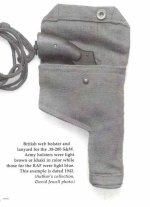Regarding blued finish, one source is from Carl Hellstrom's wartime production notes. It is fairly clear that the only Parkerized revolvers were 2187 DSC Guns shipped in mid-1942.
https://smith-wessonforum.com/s-w-h...odel-wartime-changes.html?121046=#post1285775
This is the Black Magic bluing finish product that S&W used during the war:
https://www.hubbardhall.com/product_bulletin/black-magic-infusion-2?dl=1
There was also an article in the S&W CA Journal maybe 7 years ago that discussed the Victory finishes which I have no access to. I guess the myth of Parkerized finish on Victories still lives on like a zombie. And Black Magic has no similarity to Parkerizing. Most gun manufacturers had switched to the "Black Magic" type hot oxide bath blued finish before WWII. Ned Schwing's book "Winchester Slide Action .22 Rifles" provides a very detailed discussion of Winchester's hot oxide bath bluing process used by them in the 1930s.
The "p" is a proof mark.
Somewhere, I have one of those British canvas holsters, no idea where it is now. I think I bought at an estate sale for a dollar or so. I think it was designed to be used with every revolver type ever used in British service, not just the WWII BSRs. I remember that several years ago, IMA was selling the blue canvas RAF holsters for around $10. They may have been replicas, I don't remember.



